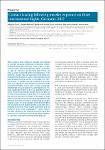Contact tracing following measles exposure on three international flights, Germany, 2017
Thole, Sebastian
Kalhoefer, Daniela
an der Heiden, Maria
Nordmann, Doris
Daniels-Haardt, Inka
Jurke, Annette
When a person with contagious measles has travelled by aircraft, European guidelines recommend contact tracing of passengers and crew within 5 days of exposure for post-exposure prophylaxis (PEP), and within 12 days of exposure for informing passengers and crew, in order to prevent further transmissions. To be effective, contact tracing requires prompt diagnosis, immediate notification of public health authorities and rapid availability of passenger contact data. We report two events of contact tracing initiated in Germany after two individuals with measles travelled on three international flights. In one event, contact tracing was initiated late because laboratory confirmation of a clinically diagnosed measles case was awaited unnecessarily. Accessing passenger contact data was difficult in both events because of data protection issues with the airline which was not based in Germany. In both events, passengers were not reached in time to provide PEP, and one event resulted in at least two secondary measles cases. As all passengers were reached before the incubation period ended, tertiary cases were most probably prevented. Public health authorities and the transport sector must collaborate to resolve competing legal regulations for infection prevention and data protection, to simplify and accelerate identification of air travellers exposed to communicable diseases.
Dateien zu dieser Publikation

